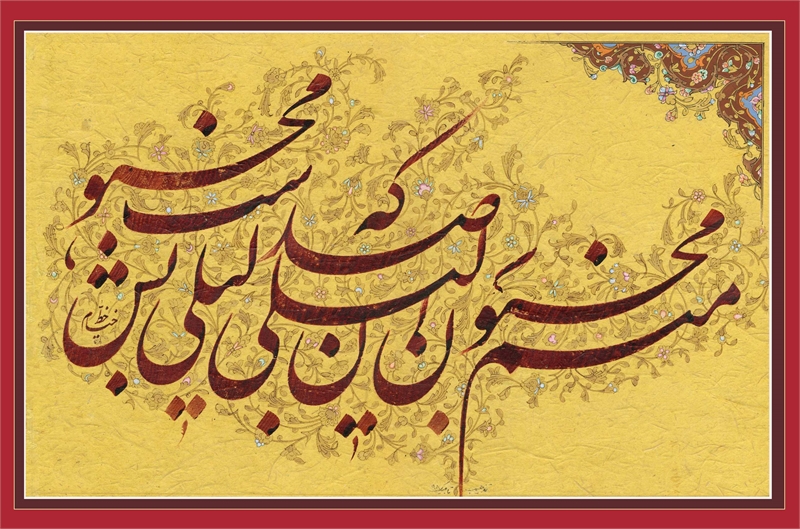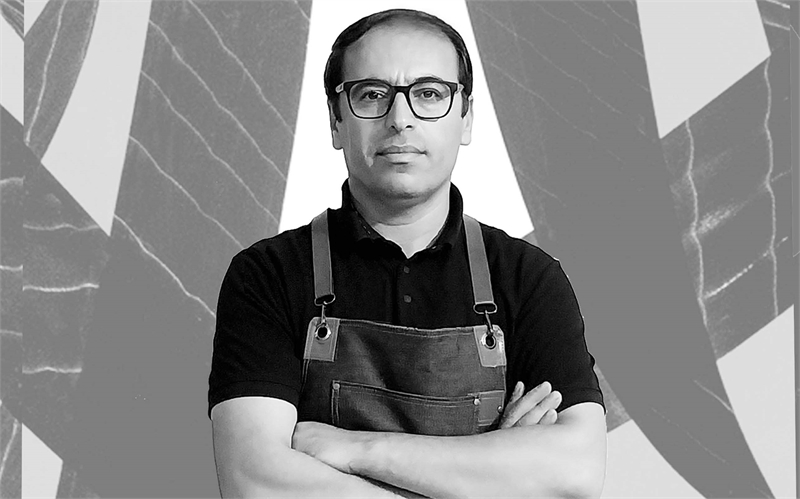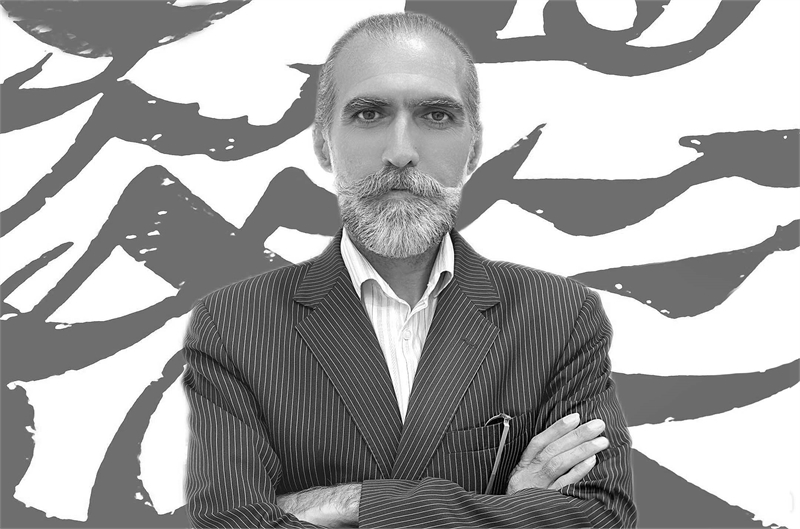Calligraphy is the art of beautiful writing and the creation of aesthetically exquisite text, and those who are skilled in this art are known as calligraphers. Iranian calligraphy is a part of Islamic calligraphy.
Calligraphy is the art of beautiful writing and the creation of aesthetically exquisite text, and those who are skilled in this art are known as calligraphers. The Naskh and Ta'liq scripts can be considered the earliest Iranian scripts that emerged in the early 4th century AH, and they are among the enduring styles in Iran attributed to Ibn Muqla Beyzavi Shirazi. Ta'liq script was serving as a writing style among literate individuals in society to compose letters and governmental decrees. Iranians transformed ordinary writings into calligraphy in the Islamic world, gradually developing their unique styles and techniques over time. The styles or scripts recognized as Iranian calligraphy were predominantly invented and utilized for writing non-religious texts, such as poetry collections, delicate artistic pieces, or for administrative correspondence.

Art Form: Calligraphy/ Type of Script: Nasta'liq (in a combined form)/ Title of the Artwork: Majnun/ Calligrapher's Name: Mr. Yadgar Khayyam/ Paper Type: Aahaar mohre (this paper is handmade)/ Paper Size: 24 x 36 centimeters/ Pen Name: Jali/ Pen Size: 11 millimeters/ Ink Name: Eshming/ This calligraphy piece features a couplet from the poetry of Hussein ibn Hassan Khaarazmi, a mystic, writer, and poet from the 8th and 9th centuries AH, who became known as Khaarazmi due to his long residence in Khaarazm.
Iranians predominantly utilized scripts such as Sols and Naskh for religious purposes, including the transcription of the Quran and Hadiths, narrations, as well as for inscribing on mosque and religious school epigraphs. They developed distinct styles within these scripts. After the advent of Islam in Iran, calligraphy in the Naskh style was prevalent, but it gained special significance during the Timurid period. Following the Ta'liq script, which was the first Iranian script to emerge, Nasta'liq developed, becoming a source of pride for Iranian art. Among Iranian and Arabic scripts, Nasta'liq is recognized as the most aesthetically pleasing script, as evidenced by the works created in this style.

Mr. Yadegar Khayyam was born in 1977 in Kurdistan Province, Iran. He spent his childhood in the beautiful mountainous landscapes of Hooraman and Marivan and has been actively engaged in the art of calligraphy for over 30 years. His professional activities and commitment to transforming the traditional structure of calligraphy education since 2010 have resulted in the approval of educational books based on the theoretical foundations of the visual arts. This effort led to the formation of the "Calligraphy Painting" committee, which includes professors from both theoretical and practical fields, and the incorporation of calligraphy painting into the charter of the Iranian Calligraphers Association. He officially began his calligraphy painting activities in 2016 and introduced the Miraji pen. A pen with the capability to execute a surface area of over two meters, which serves as a tool for realizing the artistic ideas from this artist's perspective. He has participated in over 50 national and international exhibitions and has been selected at numerous festivals, including the International Haliyah Festival (Turkey) and the Qazvin Biennial international festival (Iran). From 2015 to 2023, he served as the head of the Education Commission and was a member of the Supreme Council of the Iranian Calligraphers Association and he is also the author of a research book titled "Raze Sar be Mohr." Mr. Yadegar Khayyam, as an education designer and a member of the authorship council for the book on the art of calligraphy, holds a first-degree artistic badge and a master's degree in the art of calligraphy and he is dedicated to education, research, preservation, and promotion of this intangible cultural heritage.
Nasta'liq, or Naskh Ta'liq, emerged from the combination and integration of two scripts, Naskh and Ta'liq, which was standardized by Mir Ali Tabrizi in the 8th century AH, leading to a significant transformation in the art of calligraphy. Many masters, such as Mir Ali Hervi, Soltan Ali Mashhadi, Mir Emad Hasani, and Alireza Tabrizi (known as Alireza Abbasi) contributed to the development of Nasta'liq during its growth. Mir Emad Hasani was a contemporary of Shah Abbas Safavi, and due to his genius, brought about changes and a distinct style in the Nasta'liq script that continues to be used and inspire calligraphers even after many years.

Art Form: Calligraphy/ Type of Script: Nasta'liq in the form of a Chalipa/ Title of the Artwork: The Physician of Love/ Calligrapher's Name: Mr. Asghar Mohammadi/ Illuminator's Name: Ms. Masoumeh Farzad/ Paper Type: Aahaar mohre (this paper is handmade)/ Paper Size: 35 x 50 centimeters/ Pen Name: Mashqi/ Pen Size: 4 millimeters/ Ink Name: Traditional brown ink/ This calligraphy features verses from the poetry of Shams al-Din Hafez Shirazi (727 – 792 AH), who is considered one of the greatest and most influential Persian poets.
In general, the 9th to 11th centuries AH can be considered the golden ages of calligraphy art. From the 11th to the 13th centuries AH, the practice of Siyah Mashq evolved from a simple initial exercise into a new language and expression. This art reached its peak through the works of great calligraphers such as Mirza Gholam Reza Esfahani, Mir Hossein Khoshnevis Bashi, and Mirza Agha Khamse Zanjani during the Qajar period (1175 to 1304 SH).

Mr. Asghar Mohammadi was born in 1976 in the city of Zanjan, where he spent his childhood and he has been active in the art of calligraphy for over 30 years. His professional activities and dedication led to the establishment of calligraphy classes in local communities after he received an excellent certificate from the Iranian Calligraphers Association. He has participated in over 30 exhibitions, including the Cultural Week of Iran and South Korea, and has been selected for various festivals such as the National Waqf Festival and the assembly of Calligraphers in Iran (in this gathering, several calligraphic works are created by various skilled calligraphers at a specific time and place). He is a member of the Board of Directors of the Zanjan House of Artists, a representative of the Iranian Calligraphers Association (for two periods), and an elected supervisor for the Central Office of the Iranian Calligraphers Association. Mr. Asghar Mohammadi holds a master's degree from the Iranian Calligraphers Association and continues to strive for the education, research, preservation, and promotion of this intangible human heritage.
Iranian calligraphers, alongside cultural, artistic, political, social, and technological transformations in different periods, have laid the groundwork for various innovations in calligraphy. Today, we witness new creations and innovations that combine calligraphy with other arts and in their presentation. The quantitative and qualitative growth of calligraphy over the past forty years has been remarkable, and we are currently experiencing a period of maturity and flourishing in this art in Iran. The city of Qazvin has earned the title of the capital of Persian calligraphers due to its nurturing of great masters like Mir Emad Hassani (a prominent master of the Nasta'liq script). The traditional art of calligraphy, recognized under the national program to safeguard this heritage in Iran, was inscribed on UNESCO's World Heritage list during the sixteenth session of the Intergovernmental Committee for the Safeguarding of the Intangible Cultural Heritage in 2021.
---------------------
This article was contributed by Mr. Akbar Karimi, the international reporter for Arirang Culture Connect and the Founder and Managing Director of the Samte Ganjineye Ghoghnoos Cultural-Artistic Institute in Iran. His leadership in preserving and promoting Iranian intangible cultural heritage, along with his extensive experience in cultural-artistic research and his active participation in international forums such as UNESCO and ICCN, enriches his contributions to the global cultural dialogue.
Translated by Miss. Fereshte Abdi
Translation supervisor and director of international relations of Samte Ganjineye Ghoghnoos Institute: Mrs. Farnaz Seydi